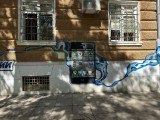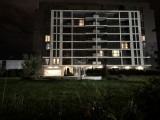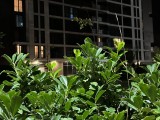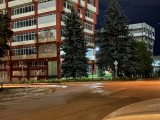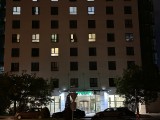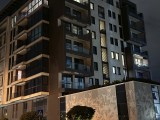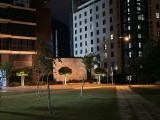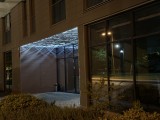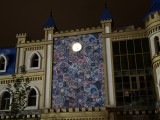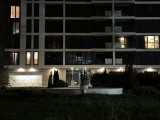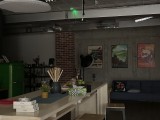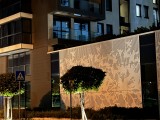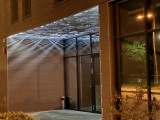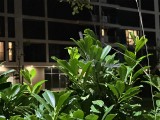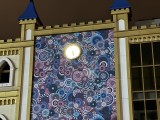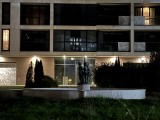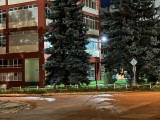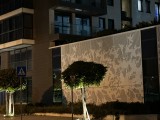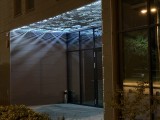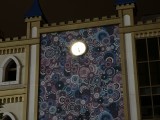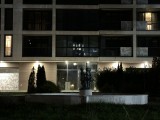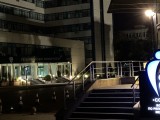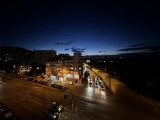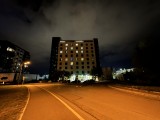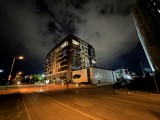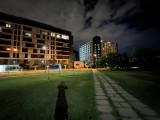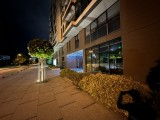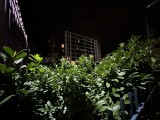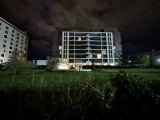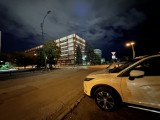Apple iPhone 14 Pro review

All-round camera improvements
The iPhone 14 Pro and Pro Max offer identical four cameras - three on the back, one at the front. And while their logic and operations seem quite like what the iPhone 13 Pro duo had, all but the telephoto camera have been improved in various ways.

The iPhone 14 Pro and Pro max feature a triple-camera setup on the back with a familiar arrangement - there is a primary camera with a wide-angle lens, a 3x telephoto is also around, as well as camera with a ultrawide-angle lens. The LiDAR scanner is here to stay, which in addition to the 3D scanning capabilities across various apps, also assists the cameras with portrait mode and focus.
There is one front camera, just like before, with a 3D ToF scanner for Face ID, which also helps the portrait mode and the autofocus.
So, the primary camera of the iPhone 14 Pro has seen the biggest update. It now uses a 48MP 1/1.28" sensor with a Quad-Bayer color filter, a first for the iPhone. The camera has a 1.22µm pixel size before binning - 2.44µm with binning. It is coupled with a 24mm f/1.78 lens. There is also second-gen sensor-shift stabilization, as well as full focus pixels.
The high-res main sensor enables a new intermediary zooming step of 2x in the camera app, by cropping from the middle and AI-assisted upscaling. High-res 48MP RAW shooting is also available in addition to the standard 12MP RAW mode.
There's a new 12MP sensor for ultrawide camera, too. It's a 1/2.55" unit with large 1.4µm pixels and should deliver sharper images with more detail and improving on macro shots, too. The lens is now 14mm f/2.2. Dual-pixel PDAF is available for this camera.
The telephoto camera has no improvements - it's still the same 12MP imager with a 1/3.5" sensor with a 77mm f/2.8 OIS lens and provides 3x optical zoom over the main camera.

The selfie camera still uses a 12MP 1/3.6" sensor, but it comes with a brighter f/1.9 23mm lens and supports autofocus. There is also OIS, something that Apple did not mention at the event, but the various teardown videos have revealed later on. It is quite a rare kit for a selfie camera, so one has to wonder why Apple didn't make a big thing out of it.
All cameras support up to 4K@60fps video capturing with Cinematic Stabilization and Expanded Dynamic Range. Dolby Vision HDR capturing is possible on all cameras in all modes. The Cinematic Mode works on the primary, telephoto and selfie cameras and now supports up to 4K HDR recording at 30fps.
There are two new Stabilization options - one is a setting called Enhanced Stabilization, and the other one is Action mode.
Enhanced stabilization crops a bit and stabilizes the footage even more. Apple has always forced electronic stabilization across its cameras, and it still does it. This new option seems to be a small improvement over the default EIS should you need it.
Action mode is quite a familiar feature to many Android phones, but it finally made it to the iPhones, exclusive to the 14 Pro series, of course. It uses heavy cropping to achieve action-camera-like stabilization and saves videos in 2K resolution or 2,816 x 1,584 px. Best used in 60fps with the ultrawide camera, but it is available to the main and telephoto cameras, too.

Finally, we can't but mention the new LED flash. It now consists of 9 LEDs within a 3x3 grid. Each of those can be independently adjusted and fired. It's a true-tone flash with slow sync, but now thanks to this new arrangement, it can also fire in a pattern like all 8 but the center LED, to illuminate wide-angle photos.
Camera app and features
The viewfinder has been mostly the same since the iOS 13 and the iPhone 11 - you can see outside of the viewfinder thanks to the precise calibration of the three cameras that allows seeing what will be left outside of the frame in real-time.
The Apple image processing includes all legacy features like the new Photonic Engine, plus the previous Smart HDR, Night Mode, and Deep Fusion.

Photonic Engine is new to the iPhone camera. It improves on Deep Fusion even more and promises 2x improvement in mid- to low-light conditions.
Deep Fusion triggers instead of Smart HDR and Night Mode when light conditions are not ideal, but it's not that dark just yet. Deep Fusion uses frames before you hit the shutter, more frames once you do, and one long exposure shot. The Neural engine will select the best frames and create a high-quality HDR photo that is very detailed, sharp, and more natural looking. The Neural processor's machine learning process analyzes the image being taken and processes them differently depending on what's in the frame - say, sky, foliage, or skin tones. Meanwhile, structure and color tones are based on ratios obtained by the Neural unit on the Apple CPU.
The Night Mode icon pops up automatically when a low-light scene presents itself, and you will see the seconds suggested next to the Night Mode icon. You can choose longer exposure or altogether disable the Night Mode.
Macro mode is available, too. Enabled by the ultrawide's camera autofocusing capability, it's an option you only get on the recent Pro modes.
As usual, all cameras talk to each other, so they already know the correct exposure and tone mapping settings when you switch between them. This applies to both stills and videos.
The camera interface is mostly unchanged unless we count the new 2x toggle between 1x and 3x. Macro toggle appears automatically if you are close enough for such a photo.
You swipe between modes and have a couple of settings you can uncover with an upward swipe - flash, night mode, live photo, photo aspect, exposure compensation, and filters. In video mode, you can change the resolution and frame rate from the viewfinder.
Portrait mode is available on the main, tele and the selfie cameras.
RAW is supported across all cameras, and it shoots in 48MP for the primary one.
There is this feature called Photographic Styles which automatically edits a photo, one element at a time (applying different corrections to the subject and background, for example). You can choose between Standard, Rich Contrast, Vibrant, Warm, and Cool. You can tune each of these modes to your liking, and set your preferred one as default. It's like filters but more permanent.
Cinematic Mode is present, and it now supports 4K HDR at 24fps and 30fps. It does automatic rack focus, but the phone records a depth map alongside the video, so you can change the focus point manually after the fact. Editing such videos is possible in iMovie and Clips apps.
Finally, there is also Action mode, which is intended to be used with the ultrawide camera at 2K@60fps, though you can use any rear camera and any resolution and frame rate. It heavily crops from the 4K stabilized footage to mimic an action camera output.
Daylight photo quality
The primary camera on the iPhone 14 Pro saves 12MP photos, as expected. Those are no different than what we got the last couple of years - the resolved detail is great, noise is not present, and the contrast is superb. The colors are accurate, as always.
Even with Smart HDR active, the photos offer a likable dynamic range, but not that wide. Apple has always preferred high-contrast photos and not over-the-top HDR, and we do agree with this approach.
The one thing that's common across many iPhone cameras is the foliage presentation, which looks artificial and over-sharpened. It's not terrible; the overall rendition is rather good, but Apple has the means to make it more natural looking.
We do understand that the intricate detail in grass and trees is a lot more than any 12MP can resolve, and this probably applies to 48MP imager, too. But, come on, we've seen what Sony can do with its 12MP cameras, how natural everything looks, and with the new 48MP sensor, we did expect this long overdue improvement. Instead, we got the same over-sharpened mess.
With all these advertisements for improved processing, improved machine learning, and with the larger 48MP sensor, we honestly expected Apple to finally catch up with some of the best in the class. Alas, the greenery hasn't improved one bit since the iPhone 13, heck, probably since the iPhone 8.
The new 48MP sensor allows Apple to offer 2x lossless zoom by cropping from the center of the 48MP image. And the 2x zoomed photos are outstanding - the detail is plenty, the sharpening is just right, and the photos are as contrasty and colorful as the standard output.
The dynamic range is also a match to the 1x photos - good, but not extremely wide.
We are glad that Apple didn't go overboard with the sharpening. Even if the per-pixel detail is a bit lower than on the default images because of the artificial 48MP upscaling, the foliage actually looks better.
You can shoot 48MP RAW photos with the iPhone 14 Pro (12MP RAW is available, too). The ones you are about to see were exported from such RAWs with 95% JPEG quality without any extra tweaking.
So, the 48MP images from the main camera are the best 48MP shots we've seen from any Quad-Bayer camera. Here comes the true power of the A16 Bionic chip, and the results are simply amazing.
The photos offer an impressive amount of detail and outstanding sharpness. Also, these images are completely free of noise. They get to keep the likable dynamic range, superb contrast, and accurate colors.
And because of the excellent qualities of the 48MP photos, when you downsize them to 12MP, you will get class-leading photos with exceptional detail, lovely sharpness, and an incredibly natural look. Noise is non-existent, contrast and colors are outstanding, while the dynamic range is just right.
If only Apple had the hardware to make 48MP and then resize them to 12MP on the go. Oh, wait...
The 3x zoomed photos delivered by the dedicated telephoto camera are excellent - they are detailed and sharp, with a natural look and likable rendition. The colors are accurate, the contrast is high, and the dynamic range is enough. Noise is still incredibly low. Overall, those are solid zoomed photos, and we have no complaints whatsoever.
Moving on to the new ultrawide camera. It features a larger sensor and a different lens. The 12MP samples we shot are some of the best ultrawide photos from a smartphone to date. They are detailed with proficient distortion correction and sharp corners. The noise is low, and the colors, contrast and dynamic range are a match to the other cameras - meaning great.
The foliage isn't looking great and is sometimes smeared or over-sharpened. But this is kind of normal for such a camera and UW lens, and we should also consider that these are some of the widest UW images we've shot.
We are really happy Apple has kept its white balance and color consistency across all cameras, something that has been consistently ignored by others.
The ultrawide camera also supports dual-pixel autofocus, which comes in handy when you want to shoot macro photos. Once you are too close to a subject, the camera will automatically switch to a macro mode, but it will be with a field of view matching the primary camera. This means that crop and upscaling is involved. That's why we prefer to just switch to the UW camera and do it by ourselves.
The UW camera can focus from as close as 4cm, and the photos are quite impressive. The subject on focus is well-developed, sharp and detailed, the colors are splendid, and the contrast is great. The noise is proficiency cleaned, the bokeh is nice, and the rendition is easily likable.
The extreme closeup shots are not exactly macro photography, alright, but we feel Apple has improved on the UW lens and processing to serve for better closeup shots on the iPhone 14 Pro, and we liked better what we saw here compared to what we shot on the iPhone 13 Pro/Max.
Apple has been one of the pioneers of portrait photos on a smartphone, and it has introduced various tweaks over the years like portrait effects and portrait lighting, as well as Night mode and, lately - Photographic styles.
This year, the new iPhone Pro generation offers 2x portraits in addition to 1x and 3x. The simulated 48mm focal length is perfect for such photos, and we expect the iPhone to excel here.
And they do! Let's start with the 1x shots. The subjects are incredibly detailed, colorful and well-exposed. Meanwhile, the background is blurred proficiently, and HDR is applied when necessary without making it too obvious. The depth map is accurate, and the separation in most cases is great, though complex backgrounds and light conditions pose a challenge.
The 2x zoomed photos are superb! The subjects are even better looking with outstanding detail and sharpness. Everything looks great - colors, contrast, dynamic range, and even the defocused background. The separation is slightly better handled than on the 1x images. The 2x is the default portrait mode, and we also think this is the way you should be taking portraits on the new iPhones.
You can do 3x portraits, too, and those are solid. They offer the most accurate subject separation, but the subjects themselves are not as sharp as when shot with the main camera. Indoor shots particularly pose a challenge, and they are often visibly noisy.
Still, the 3x outdoor portraits are as great as the rest of them, with excellent detail, colors and contrast.
This year, Apple introduced OIS and autofocus for the selfie camera, while the sensor size and the lens field of view remained the same. The camera still offers two FoV settings in the viewfinder - the slightly zoomed-in 7MP crop that is equivalent to a 30mm field of view and the full 12MP mode, which has a 23mm equivalent FoV.
If you hold the phone in portrait orientation, selfies are cropped to 7MP to provide a tighter framing but rotate the phone horizontally, and you get more of the scene with the phone automatically switching to the wider 12MP mode. You can also switch between those two modes manually by tapping on the arrows near the shutter button.
So, the 12MP selfies we took with the iPhone 14 Pro are great - they offer plenty of resolved detail, high sharpness and wide dynamic range. The contrast is kept high, and the noise has been cleaned well. The colors remain as accurate as on the rest of the cameras.
The autofocus works well, and the subject is always in focus.
The one thing we didn't like is that facial features come out a bit too pronounced by sharpening and micro-contrast enhancement. We are not fans of the skin smoothing algorithms used by other brands but Apple seems to be on the exact opposite side of the spectrum.
You can shoot selfie portraits, and they would turn up amazing. The camera is assisted by the structured-light 3D scanner and uses a detailed depth map, so the subject separation and the defocused background are among the best you can see on a selfie today. The quality is a match to the regular selfie photos.
Just like before, these portraits are shot in 7MP, meaning the camera crops a part of its available FoV and shows a zoomed-in shot. There is no option to shoot 23mm 12MP selfie portraits, unfortunately.
Low-light photo quality
Apple's Night Mode works the same as before - it triggers automatically in low-light scenes and usually chooses 1s exposure for the primary camera and 2s for the rest. You can choose a different exposure time or disable the Night Mode. Once disabled, it will stay this way until you enable it or restart the camera app.
The first set of photos we offer you below were shot on Auto, and for most, if not all of them, the algorithm chose 1s exposure time. The photos are great - the exposure is excellent, and the images are a bit brighter than reality because of the Night Mode. The resolved detail is plenty enough, and the noise is kept quite low. The color saturation deserves a praise, too.
The highlights are developed well, and the shadows have seen some brightening but nothing over the top. With that said, the contrast is notably good, and so is the dynamic range.
There won't be a major difference if you intentionally disable the Night Mode when suggested. The standard photos offer a bit lower detail and lower sharpness. The colors are not as saturated.
The regular photos are a bit darker, too, and across the darker areas, we could spot more noise. As far as dynamic range is concerned - it is often a match to the Night Mode output. That's to be expected, as Smart HDR and Deep Fusion are still at play here.
The 2x zoomed photos with Night Mode are brilliant. The resolved detail is great, and so are the contrast and dynamic range. They offer incredibly natural rendition, low noise, and impressive color rendition. These have to be the best 2x low-light photos we've seen from a smartphone.
You can opt-out of the Night Mode for the 2x photos, but we don't recommend it. Not that the photos are bad, on the contrary. They still offer more than enough detail, realistic colors and good exposure, and noise is still low.
But you can tell these are digitally zoomed photos across areas with high intricacy, they are a bit darker, with not as saturated colors and sometimes - noisier.
The phone uses the 3x tele camera at night when it shoots Night Mode photos. And those turned out great, too. The photos offer impressive detail and natural sharpness, the noise is incredibly low for a tele camera, which means it has been cleaned quite proficiently.
The 3x zoomed photos offer high contrast and superb color rendition.
If you are out of the Night Mode, you often opt out of the telephoto camera, too. But... thanks to the 48MP sensor and the AI-assisted zoom, the 3x digitally zoomed photos from the main camera are unbelievably good. If it weren't for the aperture, we could have been fooled that these came from the tele camera.
So, the 3x zoomed photos without Night Mode are still good with enough detail retained color saturation. They are darker and with lower contrast and dynamic range, and a bit noisier. But they are not only usable, but may as well beat many other non-Night mode photos from whatever cameras.
The ultrawide camera takes good low-light photos with its Night Mode. It usually chooses 2-3s exposure time. The images offer good exposure and brightness, often great contrast and higher wider than expected dynamic range. The color saturation is excellent.
The resolved detail is okay in some cases and so-so in darker scenes, as the noise reduction does eat some of it.
Overall, the UW photos shot with Night Mode are good, and presentable, and they would do just fine for most occasions.
Disabling the Night Mode results in darker and noisier photos and a saturation drop. The photos are still usable as you can see just fine what's on them; they are just not as presentable as the Night Mode-assisted ones.

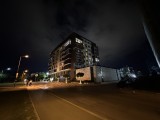
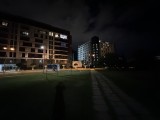
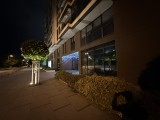


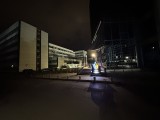
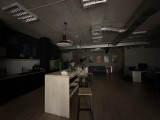
Ultrawide camera, Night Mode OFF
You can also look at our photo compare tool and see how the Apple iPhone 14 stands against other phones in the controlled environment of our test lab.



Apple iPhone 14 Pro vs. Samsung Galaxy S22 Ultra and the Xiaomi 12S Ultra in our Photo compare tool
Reader comments
- mood
- 14 Feb 2025
- Emn
🤡🤡🤡
- vurtuoso
- 25 Nov 2024
- h1g
2022... what a time huh?
- The King.
- 22 Aug 2024
- 84G
It's better. Miles better.


















































